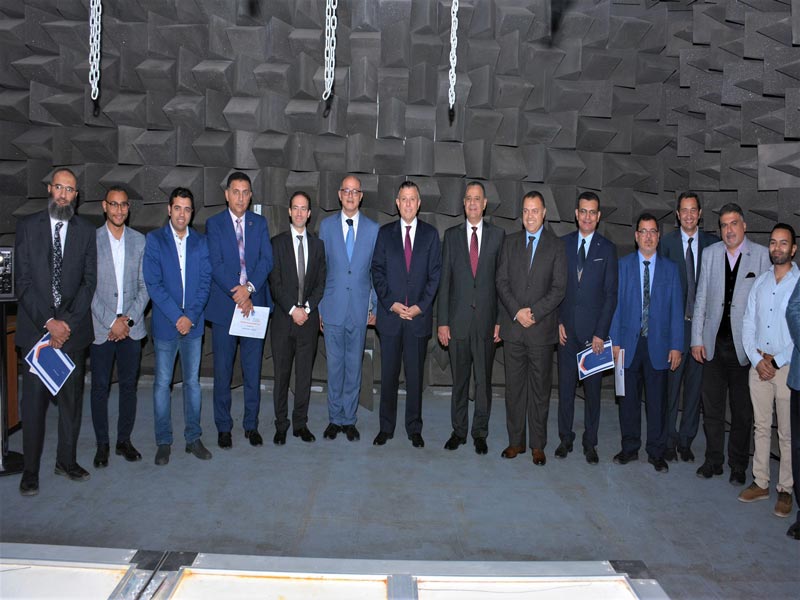The President of the University and the Dean of the Faculty of Engineering witness the inauguration of the Acoustics Building at the Faculty of Engineering
Prof. Dr. Mahmoud El-Metini, President of Ain Shams University, and Prof. Dr. Omar Al-Husseini, Dean of the Faculty of Engineering, inaugurated the Dynamic and Digitization Systems Complex in the Faculty, known as the Acoustics Building, in the presence of Prof. Dr. Ahmed Zaki Badr, Minister of Local Development and Education and former President of Ain Shams University, Prof. Dr. Sherif Hammad, former Minister of Scientific Research, Prof. Dr. Mahmoud Abu Al-Nasr, former Minister of Education and Prof. Dr. Ayman Saleh, Vice President for Postgraduate Studies and Research, Prof. Dr. Johansen Eid, President of the National Authority for Quality Assurance and Accreditation of Education and Prof. Dr. Diaa Khalil, General Supervisor of the Center for Innovation and Entrepreneurship, and Prof. Dr. Nagwa Badr, Dean of the Faculty of Computers and Information, Prof. Dr. Mustafa Refaat, Vice Dean for Education and Student Affairs. Dr. Amr Shaat, Vice Dean for Graduate Studies and Research Affairs, and Prof. Dr. Ahmed Munib Al-Sabbagh, Vice Dean for Community Service and Environmental Development, and Prof. Dr. Muhammad Al-Behairi, Director of the Center for Innovation and Entrepreneurship, and Prof. Dr. Tamer El-Nadi, Professor of Design Engineering and Head of Acoustics Building, Prof. Dr. Adel Sabbagh and Prof. Dr. Amr Al-Benhawi, Prof. Dr. Wael Nabil Akl - President of Nile University, Prof. Dr. Radwan Hassan, director of projects management at Helwan University, and Prof. Dr. Hossam Abdel-Fattah, Dean of the Faculty of Engineering, Cairo University, Dr. Eng. Mohamed Kamal Gad, the Egyptian Space Agency, Head of the Mechanical Systems Design Division, the Space Industry File Officer, Professor of Mechanical Design and a Design Consultant, Dr. Noha El-Rafei, Director of the Children's University, Ain Shams University.
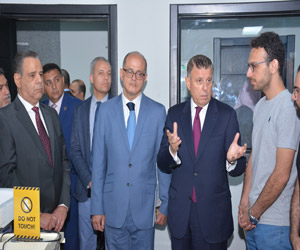 |
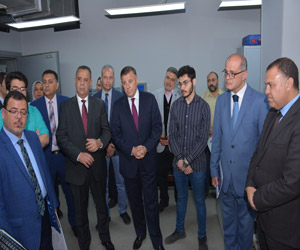 |
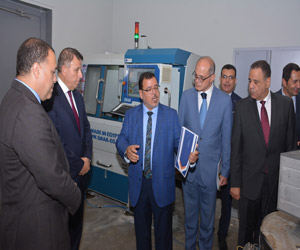 |
||
Prof. Dr. Mahmoud El-Matini, President of Ain Shams University, stressed during the opening that the university always seeks to develop, modernize and lead in the various fields of scientific research, explaining that the building is equipped with the latest devices and equipment in the field of acoustics and vibrations, which are not available in any other university or research center in Egypt.
The building, with its various research laboratories, contains various activities that keep pace with modern scientific and research trends in the world, as well as achieving the country’s goals for sustainable development, such as protecting the environment, using renewable energies, studying climate changes, building virtual reality models and digital documentation, which are the areas that international research centers are currently interested in.
He added that Ain Shams University derives its strength and leadership in scientific research from the human force represented by faculty staff, teaching assistants, researchers, workers and students, who all contribute to achieving leadership for the university through their ability to achieve tangible achievements and build scientific and research capabilities such as those found in the acoustics building.
He stressed that Ain Shams University is proud that it presents the academic community in Egypt with this new edifice, which is a model for what scientific and research facilities should be in the future, with its human capabilities, technological capabilities and advanced systems that contribute to achieving leadership in scientific research and university education in the new republic.
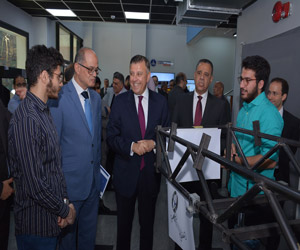 |
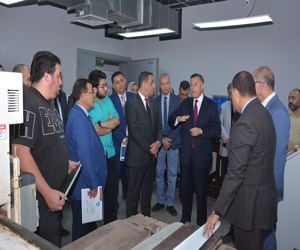 |
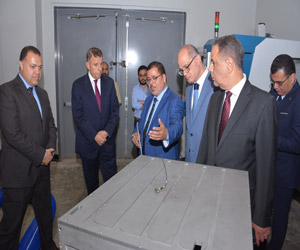 |
||
Prof. Dr. Omar Al-Husseini, Dean of the Faculty of Engineering, said that the opening of the acoustics building in the Faculty comes as a continuation of the Faculty’s engineering leadership role in the field of applications and scientific research through many funded projects that have contributed over the past years to achieving communication between the university and the community and directing scientific research to the real and applied problems facing the industry today and creating a climate Fertile for innovation, creativity and entrepreneurship in all fields in a way that enhances opportunities for creating new advanced industries in the engineering field with its various applications in Egypt and linking university education, industry and decision makers, explaining that among the main objectives of the Faculty is achieving sustainability in applied research fields and achieving regional and global spread to link and develop programs presented in a manner that achieves the maximum benefit for the region in its various dimensions on the Arab, regional and international levels.
The acoustics building is a distinguished center in the field of acoustics, vibrations, etc., as well as an open laboratory and an applied study of modern systems in building management, including systems for controlling energy, lighting, air conditioning, insurance, measurement and control. It also represents an incubator environment for innovation, including workplaces for researchers and students, as well as tools, equipment and software that Allows ideas to be transformed into real models.
Prof. Dr. Tamer El-Nadi, professor of design engineering and building manager, explained that the building’s establishment began in 2013, as a new stage after the establishment of the Acoustics and Vibrations Laboratory in 2005 with funding from the Tempus Program of the European Union to develop teaching subjects in mechanical engineering programs in the college. Since this date, the work team has succeeded in expanding and expanding through Progress to many research and educational projects funded by national and external bodies, all of which contributed to the development of human and material capabilities in the group. The team succeeded in establishing the virtual reality laboratory at the college in 2010 as the first laboratory in Egypt working in this field. Capacity building funding was obtained from the Fund The development of science and technology in 2013 to start the establishment of the complex, as well as the construction of the Energy and Climate Change lab in 2018, the Product Design Lab in 2019 and the Voice Coordination Lab for Cities in 2022; Where the work team succeeded in obtaining many research, educational and applied projects in cooperation with a large group of academic partners in expanding the field of work for the complex and included many young people to work as research assistants in these areas as well as qualifying them to contribute to advanced scientific research and conduct applied research and engineering services for industry in Egypt.
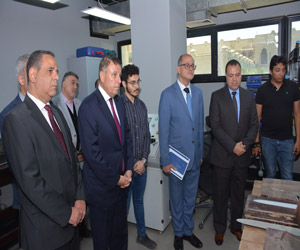 |
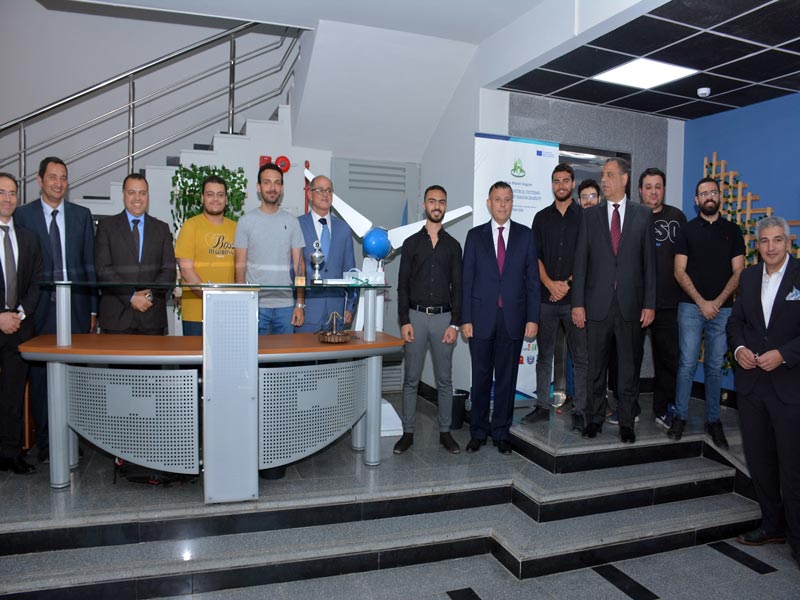 |
Prof. Dr. Adel Al-Sabbagh reviewed the research and human capabilities of the Acoustics and Vibration Lab in all its projects and the student activity carried out in it, which is a matter of pride, as the student team participates in international competitions in the field of wind turbines, and they have won many awards and advanced positions over the participating international teams.
Dr. Amr Al-Binhawi also spoke about the projects and partnerships of the Energy and Climate Change Plant, which in turn keeps pace with local and regional energy challenges through energy technology solutions that ensure sustainability and inclusion, as well as the conscious choice of the impact of that technology on climate consequences and the carbon economy.
Dr. Noha Gamal Said, head of the Urban Acoustic Coordination Lab, explained that this lab is the first Egyptian lab that deals with the relationship between sound and the city through the sensory experience of urban spaces, as it aims to study the impact of sound on the quality of daily life. Engineering for sound properties, where he studies the sound phenomena of urbanization in terms of studying three dimensions of urban space.
The President of the University also toured the building, which consists of the Acoustics and Vibration Center, smart structures, virtual reality lab, energy and climate change lab, product development lab, e-learning lab, student lab, and data center, which includes devices to measure temperature and humidity, and send a warning in case those values are violated within the permissible limits, electrical energy storage devices operate in the event of a power cut, in addition to air conditioning and refrigeration systems operating around the clock. The building also includes a system for preventing acoustics and vibrations.
.svg)

